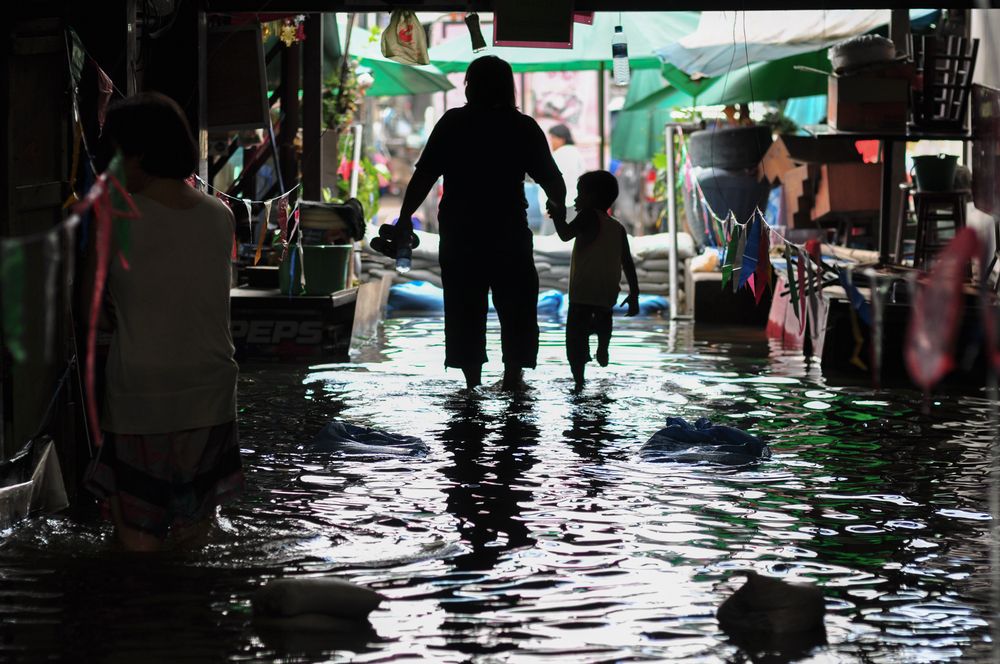Sink or swim: Keeping Jakarta and Bangkok afloat

There’s no lack of imagination in the design for Wetropolis, a new vision of Bangkok proposed by Thai architect Ponlawat Buasri. Thailand’s capital was built on highly compressible marshland; today, added pressures of unchecked urban development, excessive groundwater pumping, and concrete that cannot absorb flood water add up to a dire prognosis.
Considering rising sea levels and swelling monsoons, the city could be completely submerged in less than 15 years, Thailand’s National Reform Council warns. Buasri’s sci-fi-esque solution urges elevating the city over restored mangrove forests, which would absorb carbon dioxide, naturally filter water, and add acres of green space.
Locating the budget for such an enterprise, however, is pure fantasy, according to Dr. Supachai Tantikom. A former adviser to Bangkok’s governor and now working with 100 Resilient Cities — a Rockefeller Foundation-funded project that helps at-risk cities form resilience strategies — he says Bangkok would be better off taking a more immediately realisable approach. “We’re sinking at an average of one to two centimetres per year,” he says. “What we need is better land and water management, using existing infrastructure and resources.”
More: Why branded homes will remain hits for Thailand in 2019
The key, Dr. Supachai says, is to work with water instead of against it. He envisions diverting excess water to surrounding rice farms, for example, where it could be stored; the government would compensate farmers for their trouble. The idea recalls the Netherlands’ successful “Room for the River” project, which protects swathes of land at the expense of others; in some cases, allowing farmers’ fields to flood.
The Netherlands is a leading example of welcoming, rather than resisting, water. With one-third of the country below sea level, its cities are increasingly being landscaped to take water in, rather than keep it out. Take Rotterdam’s Benthemplein water plaza: an inviting recreational space when dry, with room for basketball, skateboarding, and an amphitheatre. When it rains, however, the plaza can capture and hold up to 1.7 million litres. This is later released into an underground filtration device, helping maintain groundwater balance during drier weather.
BANGKOK IS SINKING AT AN AVERAGE OF ONE TO TWO CENTIMETRES PER YEAR. WHAT WE NEED IS BETTER LAND AND WATER MANAGEMENT, USING EXISTING INFRASTRUCTURE AND RESOURCES
Designing cities around these principles is also catching on in China, which in 2015 launched its “Sponge City” initiative. It has since ramped up initial testing in 16 cities to a total of 30, including Shanghai.
Elsewhere, more flamboyant solutions still gain traction. Jakarta might be among the world’s fastest-growing economies, but it is also sinking faster than any other large city on Earth: an estimated 25 centimetres per year. The reasons mirror those of Bangkok’s — particularly illegal well-digging, given just one-third of its 10 million-strong population has access to piped water.
Officials are now banking on a USD40 billion project to construct a colossal dike — stretching 25 miles across Jakarta Bay — to save them. This giant sea wall would sire a lagoon, around which an all-new mega-city, gleaming with luxury skyscrapers and shopping malls, is to be built on reclaimed land. Recalling the brass of Dubai’s palm- and world-shaped man-made islands, this new metropolis has been anointed the “Great Garuda”, and is designed in the shape of the mythical bird.
Not everyone is thrilled at the idea. Criticisms range from potential environmental damage (scientists fear the lagoon’s trapped freshwater would turn septic), to human rights violations (traditional fishing communities are being evicted to make way for the development, while their livelihood — the bay’s fishing grounds — is destroyed by the construction).
Perhaps Jakarta’s problems would be better resolved by Dr. Supachai’s recommended approach for Bangkok. “The problem isn’t just the city’s; we need to study the whole catchment area,” he says. “You have to look at the bigger picture.”
This article originally appeared as one in a four-part series in Issue No. 149 of PropertyGuru Property Report Magazine
Recommended
Why everyone is moving to Selangor and Johor: Malaysia’s real estate comeback
Malaysia’s upturn in fortunes is especially prevalent in secondary destinations such as Selangor and Johor
Penang’s silicon boom: How the US-China tech war is supercharging local real estate
Penang’s booming semiconductor industry has created ripples within the local real estate sector
New leader, new opportunities: How Hun Manet is shaking up Cambodia’s real estate game
Hun Manet is overseeing decent economic growth and widening access to the country’s real estate market for foreigners
Singapore embraces inclusive housing reforms amid resilient demand
The Lion City’s regulatory strength continues to exert appeal for international investors








